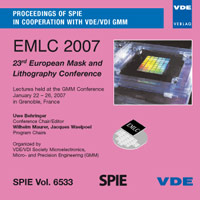Investigation of Hyper-NA Scanner Emulation for Photomask CDU Performance
Conference: EMLC 2007 - 23rd European Mask and Lithography Conference
01/22/2007 - 01/26/2007 at Grenoble, France
Proceedings: EMLC 2007
Pages: 9Language: englishTyp: PDF
Personal VDE Members are entitled to a 10% discount on this title
Authors:
Poortinga, Eric (1Carl Zeiss SMT Inc., Thornwood, NY USA)
Scheruebl, Thomas (Carl Zeiss SMS GmbH, Jena, Germany)
Conley, Will (Freescale Semiconductor Inc., Crolles, France)
Sundermann, Frank (ST Microelectronic France SAS, Crolles, France)
Abstract:
As the semiconductor industry moves toward immersion lithography using numerical apertures above 1.0 the quality of the photomask becomes even more crucial. Photomask specifications are driven by the critical dimension (CD) metrology within the wafer fab. Knowledge of the CD values at resist level provides a reliable mechanism for the prediction of device performance. Ultimately, tolerances of device electrical properties drive the wafer linewidth specifications of the lithography group. Staying within this budget is influenced mainly by the scanner settings, resist process, and photomask quality. Tightening of photomask specifications is one mechanism for meeting the wafer CD targets. The challenge lies in determining how photomask level metrology results influence wafer level imaging performance. Can it be inferred that photomask level CD performance is the direct contributor to wafer level CD performance? With respect to phase shift masks, criteria such as phase and transmission control are generally tightened with each technology node. Are there other photomask relevant influences that effect wafer CD performance? A comprehensive study is presented supporting the use of scanner emulation based photomask CD metrology to predict wafer level within chip CD uniformity (CDU). Using scanner emulation with the photomask can provide more accurate wafer level prediction because it inherently includes all contributors to image formation related to the 3D topography such as the physical CD, phase, transmission, sidewall angle, surface roughness, and other material properties. Emulated images from different photomask types were captured to provide CD values across chip. Emulated scanner image measurements were completed using an AIMS(TM)45-193i with its hyper-NA, through-pellicle data acquisition capability including the Global CDU Map(TM) software option for AIMS(TM) tools. The through-pellicle data acquisition capability is an essential prerequisite for capturing final CDU data (after final clean and pellicle mounting) before the photomask ships or for re-qualification at the wafer fab. Data was also collected on these photomasks using a conventional CD-SEM metrology system with the pellicles removed. A comparison was then made to wafer prints demonstrating the benefit of using scanner emulation based photomask CD metrology.


